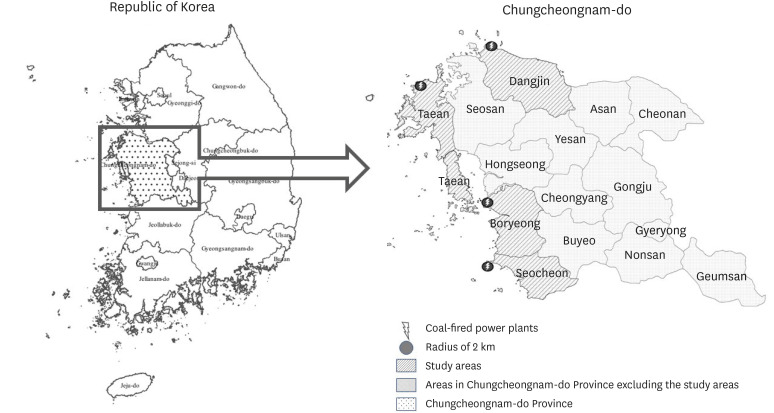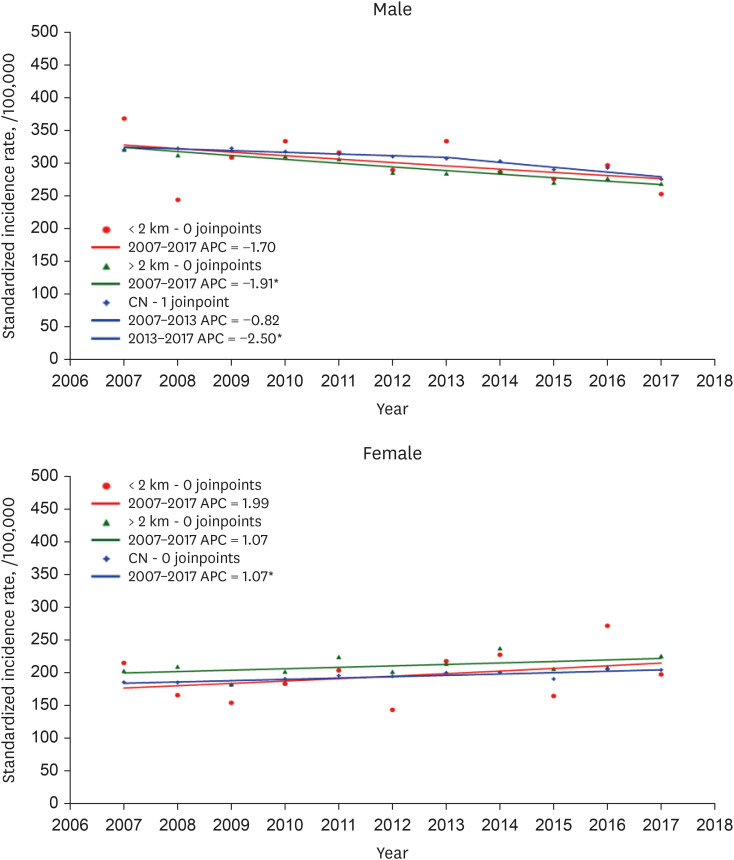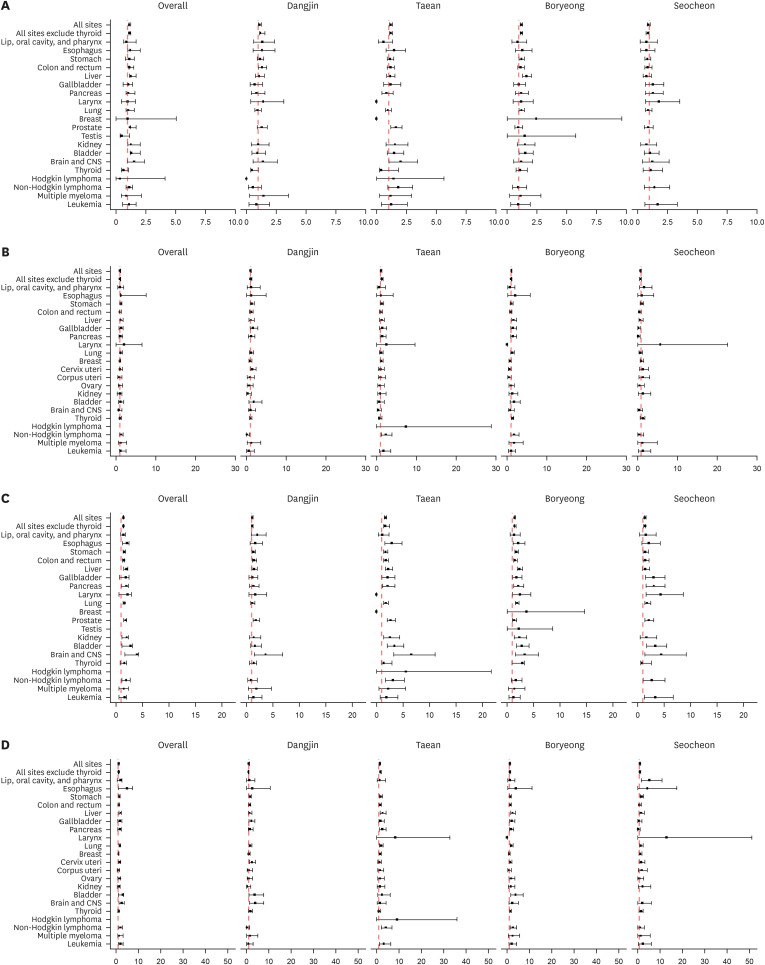J Korean Med Sci.
2024 Aug;39(30):e227. 10.3346/jkms.2024.39.e227.
Cancer Incidence Among Residents Near Coal-Fired Power Plants Based on the Korean National Health Insurance System Data
- Affiliations
-
- 1Department of Preventive Medicine, Dankook University College of Medicine, Cheonan, Korea
- 2Research Institute of Healthcare Bigdata, College of Medicine, Dankook University, Cheonan, Korea
- 3Department of Preventive Medicine and Public Health, Ajou University School of Medicine, Suwon, Korea
- 4Department of Preventive Medicine, College of Medicine, The Catholic University of Korea, Seoul, Korea
- KMID: 2558521
- DOI: http://doi.org/10.3346/jkms.2024.39.e227
Abstract
- Background
Cancer is a leading cause of death worldwide, posing a significant threat to human health and life expectancy. Numerous existing studies explored the correlation between coal-fired power plants and cancer development. Currently, Chungcheongnam-do Province hosts 29 coal-fired power plants, constituting half of the total 58 plants across South Korea.
Methods
This study assessed the cancer incidence by proximity to coal-fired power plants in Chungcheongnam-do Province, Korea. In this study, the exposed group comprised individuals residing within a 2-km radius of the coal-fired power plants, whereas the control group comprised individuals who had no prior residency within the 2-km radius of such plants or elsewhere in the province. Standardized incidence ratios were calculated using the cancer incidence cases retrieved from the National Health Insurance System data from 2007 to 2017.
Results
The study found that exposed men had a 1.11 (95% confidence interval [CI], 1.09–1.21) times higher risk of developing all cancer types and a 1.15 (95% CI, 1.09–1.22) times higher risk of developing cancers excluding thyroid cancer compared with control men. Exposed women had a 1.05 (95% CI, 1.00–1.14) times higher risk of developing all cancer types and a 1.06 (95% CI, 0.98–1.13) times higher risk of developing cancers excluding thyroid cancer than did control women. The colorectal, liver, prostate, and bladder cancer incidence rates were significantly higher in exposed men than that in all control groups. The incidence of esophageal, stomach, liver, and lung cancers were significantly higher in exposed women compared with all control groups.
Conclusion
The residents near coal-fired power plants had a higher risk of developing cancer than did those living in other areas. In the future, long-term follow-up investigations in residents living in the vicinity of power plants are warranted.
Keyword
Figure
Reference
-
1. Massetti E, Brown MA, Lapsa M, Sharma I, Bradbury J, Cunliff C, et al. Environmental Quality and the U.S. Power Sector: Air Quality, Water Quality, Land Use and Environmental Justice. Oak Ridge, TN, USA: Oak Ridge National Laboratory;2017.2. International Energy Agency. Key World Energy Statistics 2013. Paris, France: International Energy Agency;2013.3. Shahzad Baig K, Yousaf M. Coal fired power plants: emission problems and controlling techniques. J Earth Sci Clim Change. 2017; 8:404.4. Izquierdo M, Querol X. Leaching behaviour of elements from coal combustion fly ash: an overview. Int J Coal Geol. 2012; 94:54–66.5. Collarile P, Bidoli E, Barbone F, Zanier L, Del Zotto S, Fuser S, et al. Residence in proximity of a coal-oil-fired thermal power plant and risk of lung and bladder cancer in North-Eastern Italy. A population-based study: 1995–2009. Int J Environ Res Public Health. 2017; 14(8):680. PMID: 28644403.6. Tang Q, Liu G, Zhou C, Zhang H, Sun R. Distribution of environmentally sensitive elements in residential soils near a coal-fired power plant: potential risks to ecology and children’s health. Chemosphere. 2013; 93(10):2473–2479. PMID: 24091246.7. Chen CS, Yuan TH, Shie RH, Wu KY, Chan CC. Linking sources to early effects by profiling urine metabolome of residents living near oil refineries and coal-fired power plants. Environ Int. 2017; 102:87–96. PMID: 28238459.8. Cheng Z, Tang Y, Li E, Wu Q, Wang L, Liu K, et al. Mercury accumulation in soil from atmospheric deposition in temperate steppe of Inner Mongolia, China. Environ Pollut. 2020; 258:113692. PMID: 31818621.9. Rodríguez Martin JA, Gutiérrez C, Escuer M, Martín-Dacal M, Ramos-Miras JJ, Roca-Perez L, et al. Trends in soil mercury stock associated with pollution sources on a Mediterranean island (Majorca, Spain). Environ Pollut. 2021; 283:117397. PMID: 34030063.10. Rho JH, Kim BG, Kwon JY, Ju H, Kim NY, Lim HJ, et al. Comparative analysis of heavy metal exposure concentrations and volatile organic compound metabolites among residents in the affected area according to residential distance from a coal-fired power plant. J Environ Health Sci. 2024; 50(1):25–35.11. Eom SY, Lee B, Hong S, Hong YS, Choi KH, Kwon HJ, et al. Exposure to hazardous substances and their health effects among residents living near three industrial waste incinerators in Korea. J Korean Med Sci. 2023; 38(37):e289. PMID: 37724494.12. Choi KH, Lim H, Bae S, Ha M, Kwon HJ, Yoon M, et al. Cancer risk in the residents of a town near three industrial waste incinerators in Korea: a retrospective cohort study. Int Arch Occup Environ Health. 2022; 95(9):1829–1843. PMID: 35585357.13. Noh H, Seo J, Lee S, Yi N, Park S, Choi Y, et al. Cause-of-death statistics in 2020 in the Republic of Korea. J Korean Med Assoc. 2023; 66(2):132–142.14. World Health Organization. Global Health Situation and Projections Estimates. Geneva, Switzerland: World Health Organization;1992.15. Korea Electric Power Corporation. Statistics of Electric Power in Korea. Naju, Korea: Korea Electric Power Corporation;2022.16. Chungnam Provincial Government. A Study on the Health Effects among the Residents around Chungnam Coal-Fired Power Plant. Hongseong, Korea: Chungnam Provincial Government;2022.17. Song SO, Jung CH, Song YD, Park CY, Kwon HS, Cha BS, et al. Background and data configuration process of a nationwide population-based study using the Korean national health insurance system. Diabetes Metab J. 2014; 38(5):395–403. PMID: 25349827.18. Yang MS, Park M, Back JH, Lee GH, Shin JH, Kim K, et al. Validation of cancer diagnosis based on the National Health Insurance Service Database versus the National Cancer Registry Database in Korea. Cancer Res Treat. 2022; 54(2):352–361. PMID: 34353000.19. Park S, Oh CM, Cho H, Lee JY, Jung KW, Jun JK, et al. Association between screening and the thyroid cancer “epidemic” in South Korea: evidence from a nationwide study. BMJ. 2016; 355:i5745. PMID: 27903497.20. Boyle P, Parkin DM. Cancer registration: principles and methods. Statistical methods for registries. IARC Sci Publ. 1991; (95):126–158. PMID: 1894318.21. International Agency for Research on Cancer. Agents Classified by the IARC Monographs. Lyon, France: International Agency for Research on Cancer;2021.22. Flues M, Moraes V, Mazzilli BP. The influence of a coal-fired power plant operation on radionuclide concentrations in soil. J Environ Radioact. 2002; 63(3):285–294. PMID: 12440517.23. Bednar AJ, Averett DE, Seiter JM, Lafferty B, Jones WT, Hayes CA, et al. Characterization of metals released from coal fly ash during dredging at the Kingston ash recovery project. Chemosphere. 2013; 92(11):1563–1570. PMID: 23706374.24. Sager M. Environmental aspects of trace elements in coal combustion. Toxicol Environ Chem. 1999; 71(1-2):159–183.25. Nalbandian H. Trace Element Emissions from Coal. London, UK: IEA Clean Coal Centre;2012.26. Goodarzi F, Huggins FE. Monitoring the species of arsenic, chromium and nickel in milled coal, bottom ash and fly ash from a pulverized coal-fired power plant in western Canada. J Environ Monit. 2001; 3(1):1–6. PMID: 11253001.27. Chan PC, Huff J. Arsenic carcinogenesis in animals and in humans: mechanistic, experimental, and epidemiological evidence. J Environ Sci Health Part C Environ Carcinog Ecotoxicol Rev. 1997; 15(2):83–122.28. Hong YS, Song KH, Chung JY. Health effects of chronic arsenic exposure. J Prev Med Public Health. 2014; 47(5):245–252. PMID: 25284195.29. Wang CH, Hsiao CK, Chen CL, Hsu LI, Chiou HY, Chen SY, et al. A review of the epidemiologic literature on the role of environmental arsenic exposure and cardiovascular diseases. Toxicol Appl Pharmacol. 2007; 222(3):315–326. PMID: 17433393.30. Kuo CC, Moon KA, Wang SL, Silbergeld E, Navas-Acien A. The association of arsenic metabolism with cancer, cardiovascular disease, and diabetes: a systematic review of the epidemiological evidence. Environ Health Perspect. 2017; 125(8):087001. PMID: 28796632.31. James KA, Marshall JA, Hokanson JE, Meliker JR, Zerbe GO, Byers TE. A case-cohort study examining lifetime exposure to inorganic arsenic in drinking water and diabetes mellitus. Environ Res. 2013; 123:33–38. PMID: 23507312.32. Grau-Perez M, Kuo CC, Gribble MO, Balakrishnan P, Jones Spratlen M, Vaidya D, et al. Association of low-moderate arsenic exposure and arsenic metabolism with incident diabetes and insulin resistance in the strong heart family study. Environ Health Perspect. 2017; 125(12):127004. PMID: 29373862.33. von Ehrenstein OS, Poddar S, Yuan Y, Mazumder DG, Eskenazi B, Basu A, et al. Children’s intellectual function in relation to arsenic exposure. Epidemiology. 2007; 18(1):44–51. PMID: 17149142.34. Rodríguez-Barranco M, Gil F, Hernández AF, Alguacil J, Lorca A, Mendoza R, et al. Postnatal arsenic exposure and attention impairment in school children [au]. Cortex. 2016; 74:370–382. PMID: 25682472.35. Rosado JL, Ronquillo D, Kordas K, Rojas O, Alatorre J, Lopez P, et al. Arsenic exposure and cognitive performance in Mexican schoolchildren. Environ Health Perspect. 2007; 115(9):1371–1375. PMID: 17805430.36. George CM, Brooks WA, Graziano JH, Nonyane BA, Hossain L, Goswami D, et al. Arsenic exposure is associated with pediatric pneumonia in rural Bangladesh: a case control study. Environ Health. 2015; 14(1):83. PMID: 26497043.37. Sanchez TR, Perzanowski M, Graziano JH. Inorganic arsenic and respiratory health, from early life exposure to sex-specific effects: a systematic review. Environ Res. 2016; 147:537–555. PMID: 26891939.38. Dauphiné DC, Ferreccio C, Guntur S, Yuan Y, Hammond SK, Balmes J, et al. Lung function in adults following in utero and childhood exposure to arsenic in drinking water: preliminary findings. Int Arch Occup Environ Health. 2011; 84(6):591–600. PMID: 20972800.39. Wang W, Xie Z, Lin Y, Zhang D. Association of inorganic arsenic exposure with type 2 diabetes mellitus: a meta-analysis. J Epidemiol Community Health. 2014; 68(2):176–184. PMID: 24133074.40. Casey JA, Su JG, Henneman LRF, Zigler C, Neophytou AM, Catalano R, et al. Improved asthma outcomes observed in the vicinity of coal power plant retirement, retrofit, and conversion to natural gas. Nat Energy. 2020; 5(5):398–408. PMID: 32483491.41. James KA, Byers T, Hokanson JE, Meliker JR, Zerbe GO, Marshall JA. Association between lifetime exposure to inorganic arsenic in drinking water and coronary heart disease in Colorado residents. Environ Health Perspect. 2015; 123(2):128–134. PMID: 25350952.42. Coronado-González JA, Del Razo LM, García-Vargas G, Sanmiguel-Salazar F, Escobedo-de la Peña J. Inorganic arsenic exposure and type 2 diabetes mellitus in Mexico. Environ Res. 2007; 104(3):383–389. PMID: 17475235.43. Kumar B, Verma VK, Kumar S, Sharma CS. Polycyclic aromatic hydrocarbons in residential soils from an Indian City near power plants area and assessment of health risk for human population. Polycycl Aromat Compd. 2014; 34(3):191–213.44. Boffetta P, Jourenkova N, Gustavsson P. Cancer risk from occupational and environmental exposure to polycyclic aromatic hydrocarbons. Cancer Causes Control. 1997; 8(3):444–472. PMID: 9498904.45. Tchounwou PB, Yedjou CG, Patlolla AK, Sutton DJ. Heavy metal toxicity and the environment. Exp Suppl. 2012; 101:133–164. PMID: 22945569.46. Tchounwou PB, Ayensu WK, Ninashvili N, Sutton D. Environmental exposure to mercury and its toxicopathologic implications for public health. Environ Toxicol. 2003; 18(3):149–175. PMID: 12740802.
- Full Text Links
- Actions
-
Cited
- CITED
-
- Close
- Share
- Similar articles
-
- Increased Screening Rates for Thyroid Cancer Among Residents Living Near Nuclear Power Plants
- Manager's Attitude about Health Management of Workers in Coal Mine Industry
- Cancer Risk in Adult Residents near Nuclear Power Plants in Korea: A Cohort Study of 1992-2010
- Particulate Matter and Bronchial Asthma
- Introduction to the forensic research via omics markers in environmental health vulnerable areas (FROM) study




